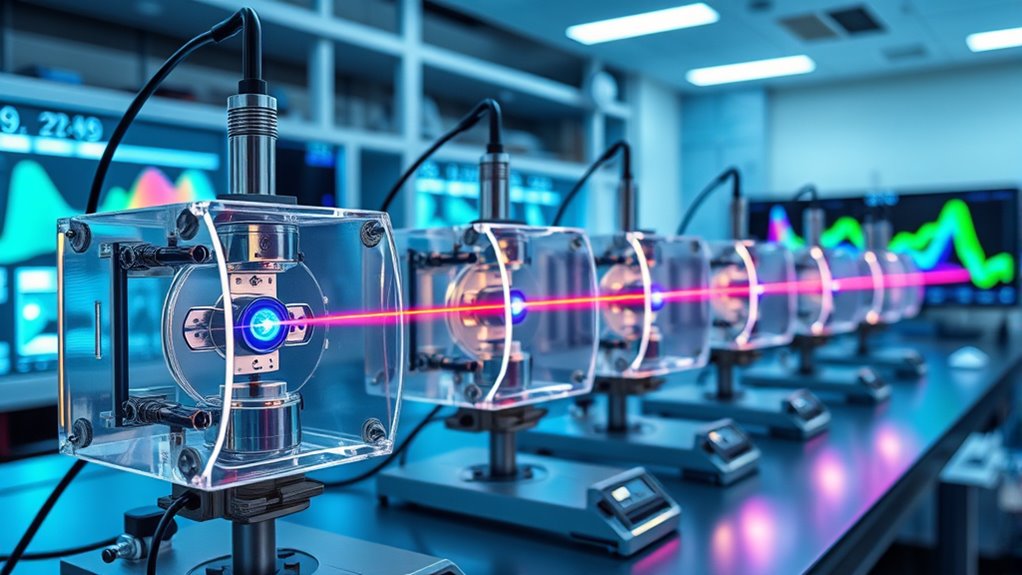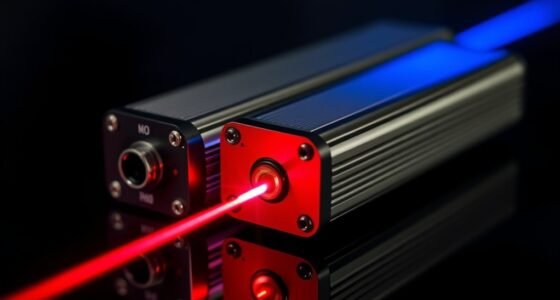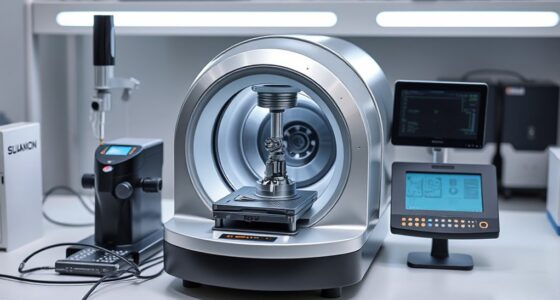If you’re searching for the 13 best optical interferometers in 2025, I recommend considering devices with high precision, durable sealing, and versatile features suitable for industrial, research, or optical applications. Look for models with laser calibration, customizable options, and advanced data output for accurate measurements down to 1μm. Ensuring environmental resilience and ease of use are also key. Keep exploring now to discover which interferometers fit your needs for ultimate accuracy and reliability.
Key Takeaways
- Prioritize models with laser calibration and sub-micron accuracy for high-precision measurement needs.
- Consider devices with robust sealing (IP55 or higher) for reliable performance in harsh environments.
- Evaluate compatibility with fiber optic data transfer for real-time, high-speed measurement applications.
- Look for user-friendly interfaces with clear displays, automated calibration, and troubleshooting features.
- Balance budget constraints with desired features like resolution, durability, and compliance with IEC/ISO standards.
Optical Power Meter with Visual Fault Locator

If you’re a fiber optic technician looking for an all-in-one testing device, the Optical Power Meter with Visual Fault Locator is an excellent choice. It combines an optical power meter, VFL, and cable tester in one compact unit, supporting seven wavelengths for versatile testing. With a range from -70 dBm to +10 dBm, it accurately measures fiber loss and detects faults like breaks or macro bends. Its ergonomic design allows one-handed operation, and the bright LCD makes readings clear even in tough conditions. The built-in VFL helps locate faults up to 30 km away, making troubleshooting quick and efficient in the field.
Best For: fiber optic technicians and field engineers seeking a versatile, all-in-one testing tool for accurate fiber, LAN, and fault diagnostics in various field conditions.
Pros:
- Combines multiple functions (OPM, VFL, cable tester) into a compact, portable device for convenience.
- Supports seven wavelengths and a wide test range for versatile and precise fiber testing.
- Bright LCD display and ergonomic design facilitate easy, one-handed operation even in challenging environments.
Cons:
- Optical covers can be difficult to open, potentially delaying testing procedures.
- VFL light activates immediately when opening the flap, which may cause discomfort or distraction.
- Some units have limited compatibility with certain adapters and charging cables, and lack locking connectors or detailed instructions.
DRO Sets for Bridgeport Milling Machine

DRO sets for Bridgeport milling machines are an excellent choice for precision-oriented operators who demand accurate measurements during machining. These systems feature a 2-axis digital readout with a 7-inch true color LCD screen, making it easy to read and interpret data. The laser-interferometer calibration guarantees high accuracy, with 12×30 linear scales providing 5-micron resolution. Built with a durable, full sealing structure (IP55 rated), they resist swarf and coolant, enhancing longevity. Customizable options, such as slim scales, allow for tailored setups. With fast shipping and extensive specifications, these DRO sets are reliable tools to boost precision and productivity in milling operations.
Best For: precision-focused machinists and operators seeking accurate, reliable measurement tools for Bridgeport milling machines.
Pros:
- High accuracy calibration with laser interferometer and 5-micron resolution scales.
- Durable full sealing IP55 structure protects against swarf and coolant.
- User-friendly 7-inch true color LCD display with helpful machining features.
Cons:
- Customization options like slim scales may require special ordering.
- Installation and setup might need technical expertise for optimal calibration.
- Limited to 2-axis measurement, which may not suit complex multi-axis applications.

This 24×36 gallery poster of the Navy Optical Interferometer in Flagstaff, Arizona, is the perfect choice for astronomy enthusiasts and collectors who value museum-quality artwork. Crafted with satin-finish photo paper, it offers vibrant, accurate colors and a smooth surface. The poster is 4 times thicker than standard prints, making it durable and resistant to tearing. Printed with archival-grade, fade-resistant ink, it promises long-lasting vibrancy. Packaged in a sturdy mailing tube for protection, it’s ready for framing or display. Whether for a home or office, this poster combines quality, durability, and visual appeal, making it an ideal addition to any astronomy lover’s collection.
Best For: astronomy enthusiasts, collectors, and anyone seeking a high-quality, durable, and visually striking poster of the Navy Optical Interferometer in Flagstaff, Arizona.
Pros:
- Museum-quality satin-finish print with vibrant, accurate colors
- Thick, durable material resistant to tearing and damage
- Archival-grade, fade-resistant ink ensures long-lasting vibrancy
Cons:
- Larger size (24×36 inches) may require a spacious display area
- May need framing to prevent damage during handling or display
- Shipping in a mailing tube could require careful unrolling to avoid creases
Professional Digital Lensmeter Auto Focimeter for Optical Labs
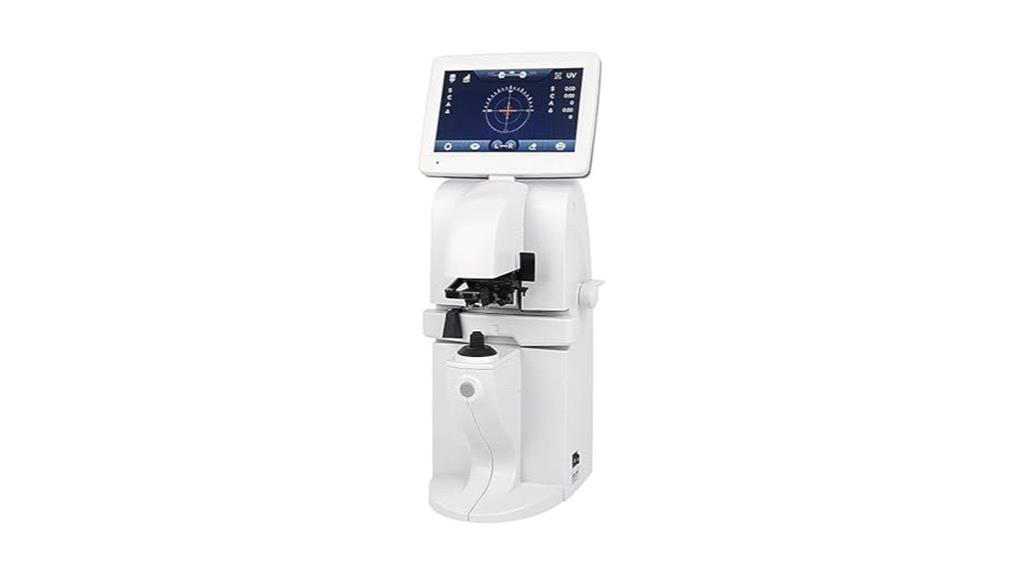
The Professional Digital Lensmeter Auto Focimeter is the ideal choice for optical labs seeking precise, rapid measurements across a wide range of lens types. It employs advanced Hartmann arrays and a 108-point simultaneous measurement system, delivering 0.01D resolution for spherical and cylindrical refraction up to ±25D. Its high-definition imaging ensures clinical-grade accuracy for single vision, bifocal, and progressive lenses. Compatible with various lens types, including polarized and high-index, it offers easy calibration via on-screen controls. The intuitive 7-inch touchscreen, combined with features like instant printing and electronic pupil measurement, streamlines workflows while maintaining durability through IEC standards and environmental resistance.
Best For: optical laboratories, optometrists, and vision care professionals seeking precise, fast, and versatile lens measurement solutions.
Pros:
- High-resolution 0.01D measurement accuracy for spherical and cylindrical refraction up to ±25D.
- Wide compatibility with various lens types, including polarized, high-index, and contact lenses.
- User-friendly 7-inch touchscreen with instant printing and electronic pupil measurement features.
Cons:
- May require initial training to fully utilize calibration and advanced features.
- Larger footprint due to comprehensive measurement capabilities might be less suitable for very small labs.
- Dependence on electronic components could lead to higher maintenance needs over time.
2Axis DRO Digital Readout Display for Metal Machinery
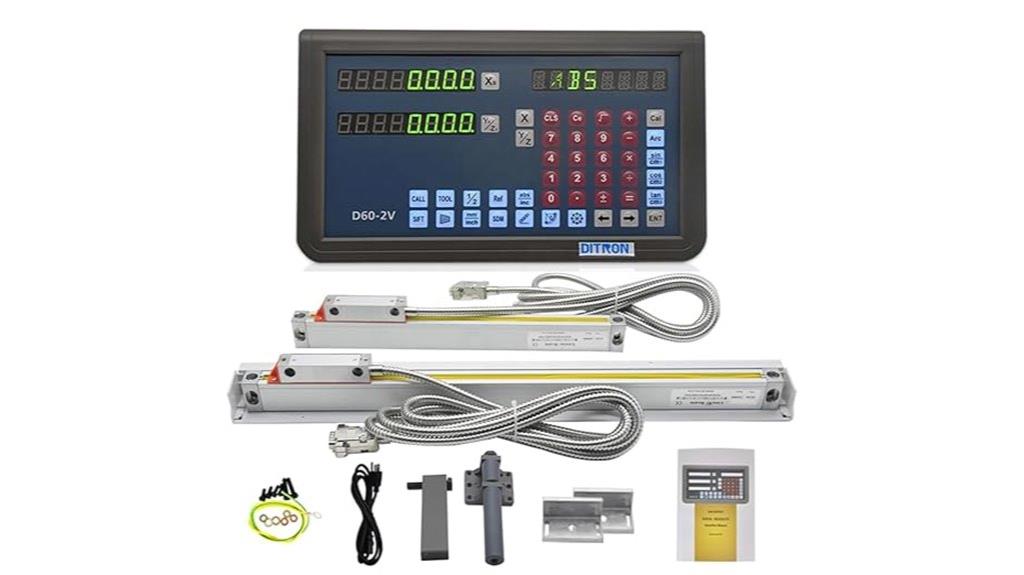
If you’re seeking precise measurement capabilities for metalworking machinery, the 2Axis DRO Digital Readout Display stands out as an ideal choice. It offers multi-functionality for lathes, milling machines, and Bridgeport knee mills, with a durable aluminum case and industrial-grade construction. The 12×32 glass optical encoder sensor ensures 5μm linear scale accuracy, calibrated by laser interferometry for guaranteed precision. Its vertical sliding system guarantees smooth, accurate movement, while the IP55 sealing protects against swarf and coolant. The display features a unique film cover for easy readability, and the unit is rated for over 100,000 on/off cycles. Customization options are also available to meet specific needs.
Best For: metalworking professionals and hobbyists seeking precise, reliable measurement tools for lathes, milling machines, and Bridgeport knee mills.
Pros:
- High accuracy of 5μm linear measurement, calibrated by laser interferometry
- Durable aluminum casing with industrial-grade sealing (IP55) for tough environments
- Easy-to-read display with protective film cover and long switch life over 100,000 cycles
Cons:
- May require specific customization for unique machinery setups
- Slightly higher cost due to industrial quality and precision features
- Limited to 2-axis measurement, which might not suit multi-axis applications
3Axis LCD DRO Digital Readout for Milling Machines
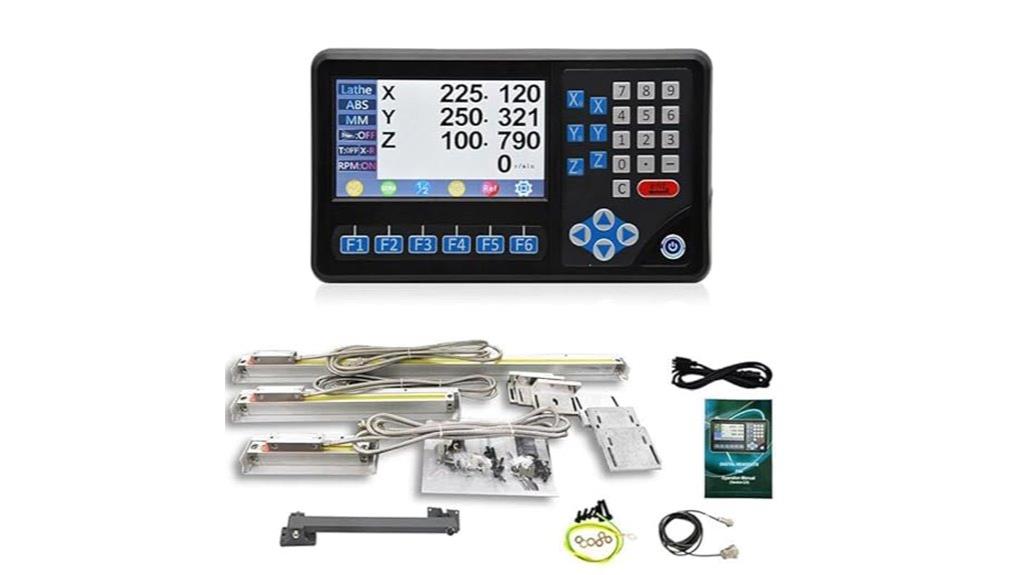
An Axis LCD DRO Digital Readout for Milling Machines equipped with multi-function RPM display and 5-micron linear scales offers unmatched precision for demanding machining tasks. Its 7-inch true color LCD screen makes data recognition effortless, while the glass optical encoder sensor guarantees high accuracy. The vertical five-bearing sliding system provides smooth, precise movement, and laser calibration assures reliable measurements. Fully sealed (IP55), it’s resistant to swarf and coolant, ideal for industrial environments. Customizable scale lengths and optional decimal modes enhance flexibility. With user-friendly operation and excellent support, this system markedly improves machining accuracy, making it a top choice for precision manufacturing in 2025.
Best For: Machinists and manufacturers seeking high-precision, reliable digital readouts for milling, lathe, and other machining equipment to enhance accuracy and efficiency.
Pros:
- High precision with laser-calibrated glass optical encoder sensor and 5-micron linear scales.
- User-friendly interface with a large 7-inch color LCD screen for easy data recognition.
- Fully sealed IP55 design ensures durability and resistance to swarf and coolant in industrial environments.
Cons:
- May require technical expertise for installation and calibration.
- Larger dimensions might require substantial space on smaller machines.
- Customization options, while flexible, could increase setup complexity for some users.
Linear Scale 1400mm (56) Optical Glass Encoder Sensor

For those working with small to medium-sized machine tools, the 1400mm (56 inches) optical glass encoder sensor offers exceptional accuracy and durability. Its 5μm resolution and laser-calibrated design guarantee precise measurements, making it ideal for lathes, mills, and drill presses. The slim 170mm profile fits compact setups, while the heavy-duty construction withstands demanding environments. With full sealing (IP55), it resists swarf and coolant, maintaining performance. The 1μm upgrade enhances precision, though some units may have issues like rough movement or missing parts. Overall, this sensor provides reliable, high-accuracy feedback for improved machine control and measurement.
Best For: professionals and hobbyists working with small to medium-sized machine tools who need precise, durable measurement solutions.
Pros:
- High accuracy with 5μm resolution and laser calibration guarantees precise measurements.
- Robust, heavy-duty construction suitable for demanding industrial environments.
- Full sealing (IP55) provides excellent protection against swarf and coolant.
Cons:
- Some units may experience rough movement or damage, especially if missing parts like the red plastic alignment spacer.
- The 1μm upgraded scale was reported to be missing components and potentially used or damaged.
- Its slim 170mm design might limit applicability for larger or more complex machine setups.
OM4 2 Meters 6ft LC to ST Duplex 10Gb Fiber Optic Cable
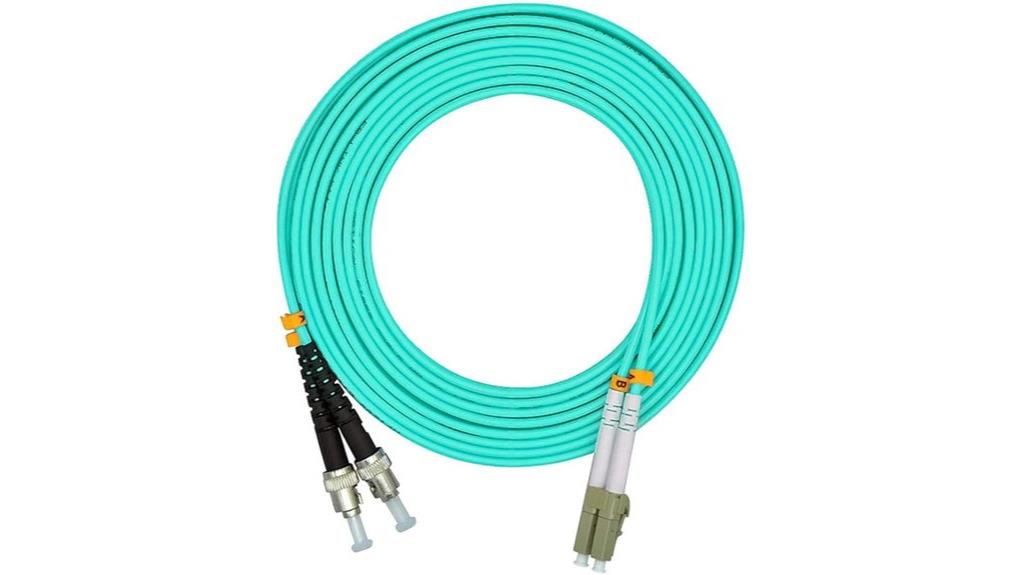
The OM4 2-meter (6-foot) LC to ST duplex fiber optic cable stands out as an ideal choice for high-speed network deployments that demand reliable, low-latency data transfer. Designed for 10Gbps to 40Gbps speeds, it supports LAN, WAN, voice projects, and data centers. With 50/125 multimode fiber and a durable aqua jacket, it’s suitable for indoor and outdoor use. The lightweight, 3mm diameter cable ensures easy installation, while high-quality connectors and a precision manufacturing process guarantee minimal signal loss and high reliability. Perfect for demanding environments, this cable helps guarantee seamless, high-performance connectivity critical for advanced optical systems.
Best For: IT professionals and network engineers seeking reliable high-speed fiber optic connections for data centers, server rooms, or enterprise LAN/WAN deployments.
Pros:
- Supports high-speed data transfer up to 40Gbps, ideal for demanding network environments.
- Constructed with high-quality materials like Corning glass and ceramic connectors for low signal loss.
- Lightweight and flexible design makes installation easier in tight or outdoor spaces.
Cons:
- Only available in 2-meter (6-foot) length, which may require additional cables for larger setups.
- Aqua jacket color, while useful for identification, may not match all infrastructure aesthetics.
- Slightly higher cost compared to lower-spec or shorter fiber optic cables.
Linear Scale Sino KA300-670mm (26) High Accuracy 5um Optical Glass Encoder Sensor

When precision matters most in industrial measurement, the Linear Scale Sino KA300-670mm (26) High Accuracy 5um Optical Glass Encoder Sensor stands out as an ideal choice. Its high calibration accuracy, guaranteed by laser interferometer, ensures reliable readings. Suitable for DRO tools, lathes, and milling machines, it offers an effective travel length tailored to specific needs. The full sealing structure resists swarf and coolant, enhancing durability. Plus, its vertical five bearings sliding system guarantees smooth, precise movement. This encoder sensor combines durability, accuracy, and stability, making it essential for precise, industrial-grade measurements in demanding environments.
Best For: professionals and technicians in industrial settings seeking high-precision measurement tools for DRO systems, lathes, milling machines, and other machining equipment.
Pros:
- Calibrated with laser interferometer for exceptional accuracy (5um).
- Fully sealed design resistant to swarf and coolant, ensuring durability.
- Smooth and stable movement thanks to vertical five bearings sliding system.
Cons:
- Effective travel length may need customization based on specific application requirements.
- Installation and calibration might require technical expertise.
- Higher initial cost compared to less precise or non-sealed alternatives.
Optical Portable Manual Lensmeter NJC-1

Looking for a reliable, portable lens measurement tool that delivers precise results quickly? The NJC-1 Optical Portable Manual Lensmeter is exactly that. Compact and lightweight, it’s perfect for optical shops and spectacles factories. It measures all key lens data—myopia, presbyopic diopters, astigmatic axes, prismatic power, and more—across various lens types, including contact lenses. Its innovative measurement method guarantees accuracy and reliability. With easy-to-use controls, adjustable eyepiece focusing, and compatibility with lenses up to 80mm, the NJC-1 ensures fast, precise readings on the go. It’s an ideal solution for quality control and prescription validation in dynamic optical environments.
Best For: optical shops and spectacles factories needing portable, accurate, and quick lens measurement solutions for various lens types.
Pros:
- Compact and lightweight design for easy portability and use in different environments
- Measures all key lens data including myopia, presbyopic diopters, astigmatic axes, and prismatic power
- Innovative measurement method ensures high accuracy and reliability across lens types
Cons:
- Limited to lenses with diameters up to 80mm, which may not suit larger lenses
- Requires both DC and AC power sources, potentially limiting use in areas with unstable power supply
- Slightly higher price point compared to basic lensmeters, which may be a consideration for budget-conscious buyers
SigOFIT Optical-Fiber Isolated Probe for High Frequency and Accuracy

If you’re working with high-frequency signals and need precise, isolated measurements, the SigOFIT Optical-Fiber Isolated Probe (model MOIP100P) stands out as an ideal choice. It offers DC to 1GHz bandwidth with 1% accuracy, ensuring reliable data capture for advanced semiconductor testing. Its design supports high common-mode voltages up to 85kVpk, making it safe for sensitive devices. Compatible with universal BNC interfaces, it reveals true signals previously hidden, even in noisy environments thanks to its high CMRR of 180dB. Whether for RF testing or digital circuits, this probe provides precise, safe, and versatile measurements essential for cutting-edge electronic development.
Best For: engineers and technicians working with high-frequency signals and sensitive semiconductor devices requiring precise, isolated measurements up to 1GHz.
Pros:
- Provides high-frequency DC-1GHz measurement with 1% accuracy for reliable data.
- Supports high common-mode voltages up to 85kVpk, ensuring safety for sensitive components.
- Compatible with universal BNC interfaces and offers high CMRR of 180dB for accurate readings in noisy environments.
Cons:
- May be more expensive than standard probes due to its specialized high-voltage and high-frequency features.
- Requires careful handling and calibration to maintain optimal accuracy at high frequencies.
- Limited to specific models within the SigOFIT lineup, which might require upgrading for different measurement ranges.
3B Scientific U10351 Interferometer Accessory Kit
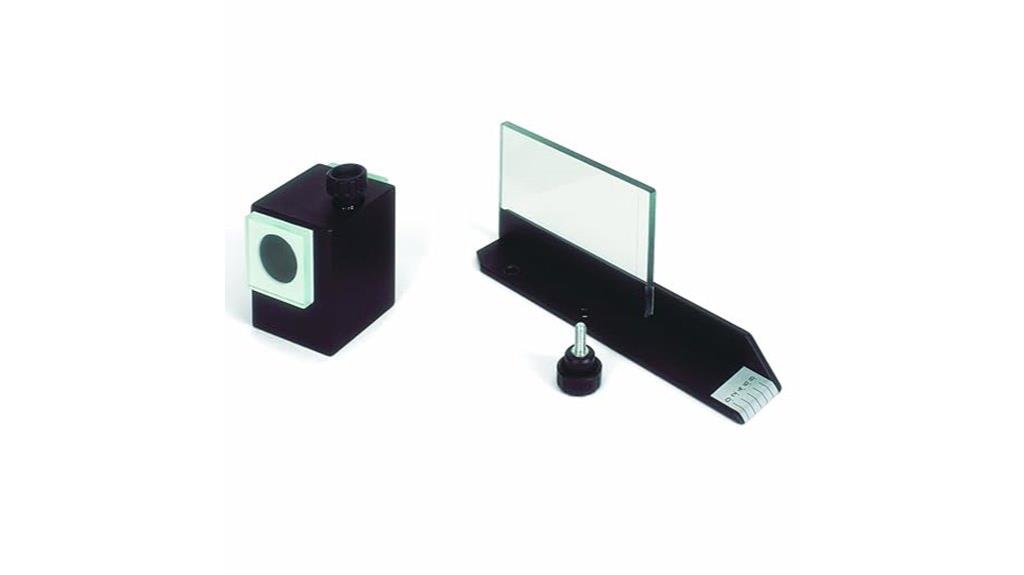
The 3B Scientific U10351 Interferometer Accessory Kit is an essential tool for professionals and students working with optical interferometry. It includes a vacuum cell for measuring the refractive index of air, which is vital for precise optical measurements. The kit also features a glass plate mounted on a rotatable holder, allowing for surface quality examination of optical components like those tested with a Twyman-Green interferometer. To operate it, you’ll need a U20500 vacuum hand pump and a silicone tube. Overall, this accessory set enhances the accuracy and versatility of interferometric experiments, making it a valuable addition to any optical laboratory.
Best For: optical scientists, engineers, and students seeking precise interferometric measurements and surface quality testing of optical components.
Pros:
- Includes essential accessories like vacuum cell and glass plate for comprehensive optical testing
- Facilitates accurate measurement of air’s refractive index, improving experiment precision
- Compatible with Twyman-Green interferometers and other optical setups
Cons:
- Requires additional equipment such as the U20500 vacuum hand pump and silicone tube for operation
- May involve a learning curve for first-time users unfamiliar with interferometric accessories
- Limited to optical interferometry applications; not suitable for non-optical measurements
Optical Manual Lensmeter NJC-4 Portable Optical Focimeter
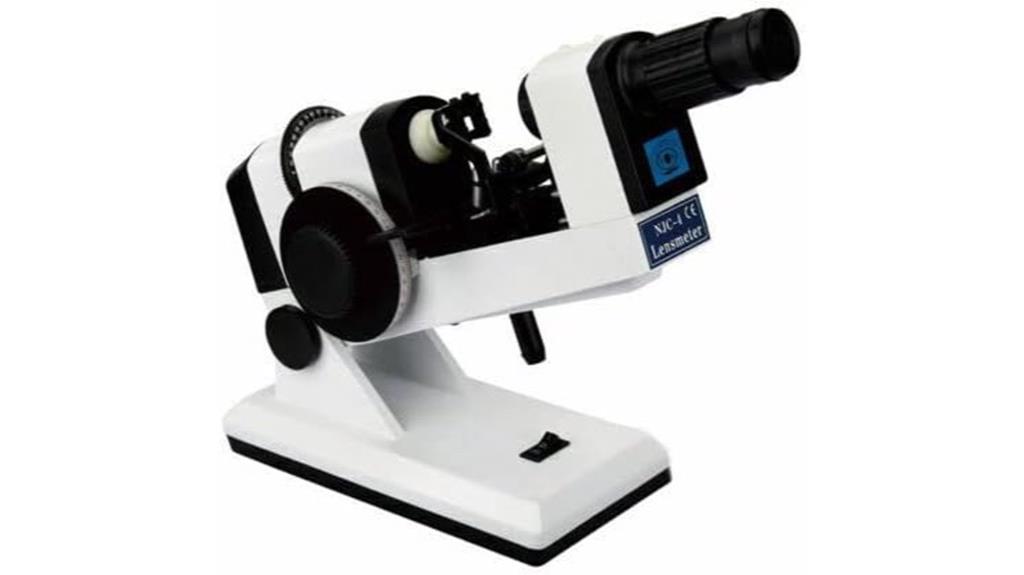
The Optical Manual Lensmeter NJC-4 is an essential tool for eyewear professionals seeking precise, portable lens measurements. I find it versatile, capable of measuring spherical and cylinder diopters, axis, and shuttle lens baseline direction. Its clear graduations and optical center stamping ensure accurate lens positioning during manufacturing or fitting. With a measurement range of 0.125D and compatibility with all lens types, the NJC-4 guarantees reliable results in various settings. Compact and easy to operate, it supports high accuracy and efficiency, making it an indispensable device for optical stores, manufacturers, and hospitals aiming for precision in 2025.
Best For: optical store professionals, glasses manufacturers, and ophthalmological hospitals seeking precise, portable lens measurement tools.
Pros:
- Accurate measurement of spherical and cylinder diopters, axis, and shuttle lens baseline
- Portable and easy to operate with clear graduations and optical center stamping
- Compatible with all lens types, ensuring versatile use across various settings
Cons:
- Does not include a battery; requires AC power for operation
- Limited to a maximum lens diameter of 100mm which may not suit larger lenses
- Slight learning curve for new users unfamiliar with optical measurement devices
Factors to Consider When Choosing Optical Interferometers
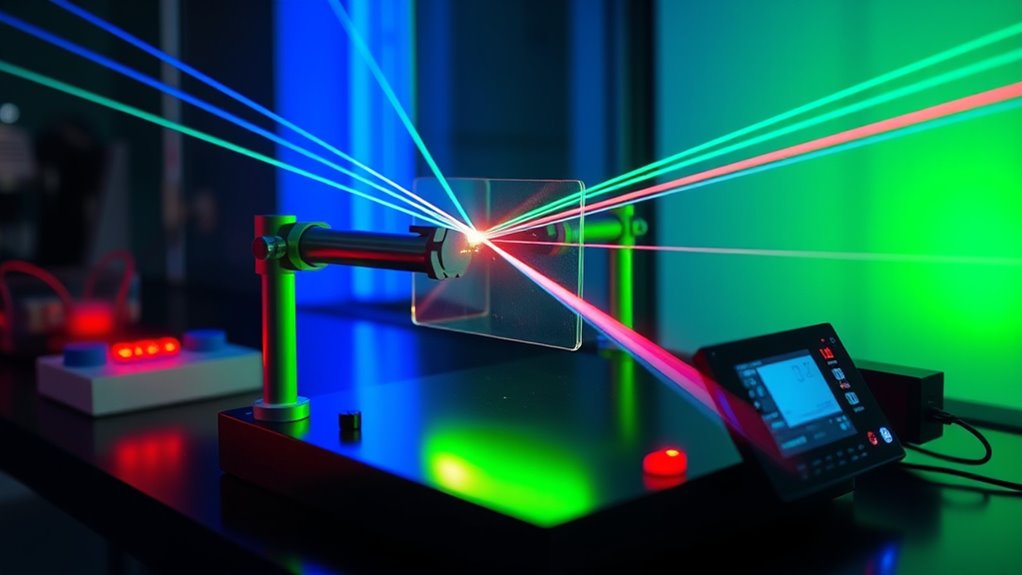
When selecting an optical interferometer, I focus on measurement accuracy standards and whether the device matches the required precision for my work. I also consider the wavelength compatibility range, portability, and ease of calibration to guarantee it fits my environment and needs. Additionally, environmental resistance features are vital for maintaining performance in various conditions.
Measurement Accuracy Standards
Choosing the right optical interferometer depends heavily on understanding the measurement accuracy standards that apply to your specific needs. Typically, these standards demand resolution levels of at least 0.01D for spherical and cylindrical measurements. Calibration is vital; I recommend using laser interferometers to ensure high precision and traceability to national measurement standards. Environmental factors like temperature fluctuations, vibrations, and air refractive index changes can impact accuracy, so they must be carefully controlled or compensated for. Additionally, interferometers should adhere to IEC or ISO standards for dimensional and optical measurement accuracy, guaranteeing reliable, standardized results. Regular validation and calibration are essential to maintain measurement accuracy within specified tolerances throughout the instrument’s lifespan, guaranteeing consistent, precise measurements over time.
Wavelength Compatibility Range
Selecting an optical interferometer requires careful attention to its wavelength compatibility range to guarantee accurate measurements for your specific applications. You need to confirm the device supports the wavelengths relevant to your work, such as 400-700 nm for visible light or 1300-1600 nm for telecommunications. Compatibility with multiple wavelengths allows for versatile testing of fiber types, lenses, and optical components. It’s essential to verify the interferometer can measure at critical wavelengths like 850 nm, 1310 nm, or 1550 nm to maintain precision. Devices with broader wavelength ranges can streamline workflows by reducing the need for multiple instruments. Additionally, ascertain that the optical components and calibration are optimized across the entire spectrum, ensuring measurement accuracy at every supported wavelength.
Device Portability and Size
Have you considered how the size and portability of an optical interferometer can influence your testing workflow? Portable units, often weighing less than 2 kg, make it easy to move between labs and field sites. Compact designs, like handheld or small rack-mount models, save space and allow quick setup in confined areas. This flexibility is vital for on-site inspections, field research, or mobile testing where mobility is essential. Larger interferometers are typically stationary, requiring dedicated lab space, which offers better stability and potentially higher precision but limits mobility. When choosing, balance your need for portability with the measurement complexity and environmental conditions. Smaller, portable devices enhance flexibility, but may sacrifice some stability compared to larger, fixed systems.
Ease of Calibration
The ease of calibration plays a essential role in how efficiently an optical interferometer can be integrated into your testing process. A straightforward calibration procedure allows for quick setup and guarantees measurements are reliable from the start. Instruments with intuitive interfaces and clear instructions reduce user error and minimize downtime, saving valuable time. Complex calibration steps or the need for specialized tools can slow progress and increase the chance of inaccuracies. I also look for interferometers with stable calibration references or self-calibration features, which help maintain measurement accuracy over time. Ultimately, selecting a device with simple, efficient calibration procedures ensures consistent results and enhances overall productivity, making it a crucial factor when choosing the right optical interferometer for your needs.
Environmental Resistance Features
Are you considering an optical interferometer for use in demanding environments? If so, environmental resistance features are essential. Look for models with full sealing structures rated at least IP55, ensuring protection against dust, swarf, and coolant intrusion. A robust construction, like heavy-duty aluminum casings, helps withstand impacts and harsh conditions. Verify that the optical and electronic components are sealed to prevent moisture and contaminant ingress, which can compromise accuracy. Protective measures such as corrosion-resistant coatings and sealed connectors are crucial for long-term reliability. Additionally, opt for systems with dust caps or covers for sensitive optics and interfaces to preserve calibration and functionality. These features collectively ensure consistent performance, even in challenging environments, safeguarding your investment and measurement integrity over time.
Data Output Options
When choosing an optical interferometer, the data output options play a essential role in ensuring seamless integration with your existing measurement systems. I consider whether it offers digital displays, analog signals, or digital interfaces like USB, Ethernet, or HDMI, as compatibility impacts workflow efficiency. High-resolution digital outputs are indispensable for transferring precise data, enabling detailed analysis and accurate record-keeping, especially in research and quality control. I also look for real-time data streaming capabilities, which allow live monitoring and immediate adjustments during measurements. Compatibility with data acquisition systems and ease of integration are fundamental factors that influence my choice. These options determine how smoothly the interferometer fits into my setup, affecting overall productivity and the quality of results.
User Interface Design
How does the user interface design impact the ease of operating an optical interferometer? A well-designed interface makes the device more intuitive and reduces user errors. Clear menus and icons allow for straightforward navigation, enabling quick adjustments and setup. Touchscreen displays with customizable layouts and helpful prompts enhance workflow efficiency, especially during complex measurements. Compatibility with multiple input methods, like buttons and touchscreens, caters to different user preferences, making operation more flexible. Automated calibration reminders and troubleshooting guides boost confidence by ensuring accurate results and minimizing downtime. Overall, a thoughtful user interface simplifies operation, saves time, and improves data reliability, which is vital for precise measurements in demanding research and industrial environments.
Cost and Budget Considerations
Choosing the right optical interferometer depends heavily on your budget, as these systems can vary widely in cost. Basic models start around a few thousand dollars, suitable for entry-level applications, while advanced systems with multiple features can exceed $100,000. Budget constraints may lead you to select simpler or portable models, but keep in mind they might offer lower accuracy or fewer functionalities. Investing in a more expensive system often provides better stability, higher resolution, and increased durability, which can reduce long-term maintenance costs. It’s also crucial to consider the total cost of ownership, including calibration, accessories, repairs, and training. Balancing your measurement needs with your budget ensures you get the best value without overspending on unnecessary features.
Frequently Asked Questions
How Do Environmental Factors Impact Interferometer Accuracy?
Environmental factors can considerably impact the accuracy of an interferometer. I’ve seen temperature fluctuations cause expansion or contraction of components, leading to measurement errors. Vibration and acoustic noise also disrupt delicate interference patterns, while air currents and humidity change the optical path length. To maintain precision, I always guarantee proper environmental controls, like stable temperature, vibration isolation, and controlled humidity, which help me get reliable, accurate measurements.
What Is the Typical Lifespan of High-Precision Optical Interferometers?
Think of a high-precision optical interferometer like a fine-tuned musical instrument; with proper care, it can last decades. Typically, these devices have a lifespan of 10 to 20 years, but with regular calibration and maintenance, they can serve well beyond that. Just as a vintage guitar improves with age, careful handling guarantees your interferometer remains accurate and reliable over time.
Can Optical Interferometers Be Integrated With Automation Systems?
Yes, optical interferometers can definitely be integrated with automation systems. I’ve seen them work seamlessly with robotic positioning, data acquisition, and analysis software, which boosts precision and efficiency. When I’ve set up such systems, I find that automation not only speeds up measurements but also reduces human error. This integration is especially useful in high-precision fields like manufacturing, research, and metrology, making the entire process more reliable and scalable.
What Maintenance Is Required for Optimal Interferometer Performance?
Regular cleaning of optical surfaces with lint-free wipes and appropriate cleaning solutions keeps interferometers accurate. I recall a lab where neglecting dust removal led to measurement errors; after systematic cleaning, performance improved markedly. I also recommend calibrating the system periodically, checking alignment, and ensuring environmental stability. By maintaining cleanliness, calibration, and environmental controls, you can guarantee your interferometer delivers precise, reliable measurements consistently.
How Do Different Wavelength Choices Affect Measurement Precision?
Different wavelength choices substantially impact measurement precision. Shorter wavelengths, like ultraviolet, can detect smaller features due to higher resolution, but they’re more sensitive to environmental disturbances. Longer wavelengths, such as infrared, offer better stability and easier handling, though with slightly reduced resolution. I consider the specific measurement requirements and environmental conditions to choose the most suitable wavelength, balancing resolution needs against practical stability for accurate, reliable results.
Conclusion
Choosing the right optical interferometer can feel overwhelming, but remember, the perfect tool can revolutionize your measurements like nothing else. Whether you need high precision, portability, or versatile accessories, there’s an option for you. Trust me, investing in the right interferometer will elevate your work to levels so extraordinary, they’ll seem almost magical. Don’t settle for less—your groundbreaking innovations deserve the absolute best in optical measurement technology.
